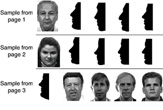Humans Can See Race and Sex Even in Simple Outlines

Adult minds are so keen at spotting race, gender and age that we can correctly guess those features from nothing more than a black-and-white silhouette, new experiments show.
"It's surprising how much information the silhouette provides," said Stanford University cognitive psychologist Nicolas Davidenko, who led the study. "We rarely have to identify a person in a silhouette, yet in the experiment, people can do that without difficulty."
The way that our brains process faces, he said, seems so flexible that our minds can even assign people to social and biological categories drawing only on views that occur less commonly in our daily lives—including black-and-white profiles.
Davidenko found that people correctly identified the gender of the person in silhouettes 70 percent of the time. Meanwhile, people guessed the correct age—to within 10 years—68 percent of the time. The study details are published in the March 21 issue of the Journal of Vision.
Hair's effect
Men were more easily identified than women and people overestimated the age of the silhouettes by an average of 8 years.
These biases, said Davidenko, might be due to the lack of hair on the silhouettes, which were cropped to show only a facial profile. This could make them seem bald in some cases, a trait common to males and generally older people.
Get the world’s most fascinating discoveries delivered straight to your inbox.
He has also found people are 85 percent accurate in identifying a person's race from a black-and-white image.
Brows, chins and noses
When studying face recognition, researchers often focus on features including the eyes, nose and mouth. But this new study suggests that certain aspects of the shape of the face appear to be key elements used to recognize a face.
For example, the width of a brow, length of chin and protrusion of a nose makes a face appear more masculine.
Davidenko has measured the contours of silhouettes in a collection of 400 face profiles to analyze, for example, which aspects tend to go with male faces and which are female.
"I hope other researchers will use this mathematically controlled method," he told LiveScience. "It provides an easy to use tool that makes research more quantitative."


